
Heckler & Koch VP70M - Tanio Koba
Tanio Koba - If you don't know the name, here's a quick lesson...
Tanio Kobayashi’s story began 40 years ago, when Kobayashi became the first employee of the future model gun giant Model Gun Corporation (MGC)
Along the way, he, almost single handed developed the first select fire gas pistol (MGC's M93R), the GBB as we know it and is responsible for the Tokyo Marui GBB mechanism.
He also started Tanio Koba, which produces the odd accessory (rifled barrels, kick boosters, etc) and the legendary Ruger 10/22.
Tanio is now 67 and decided to revisit one of his early guns, the Heckler & Koch VP70, which he felt he could improve upon.
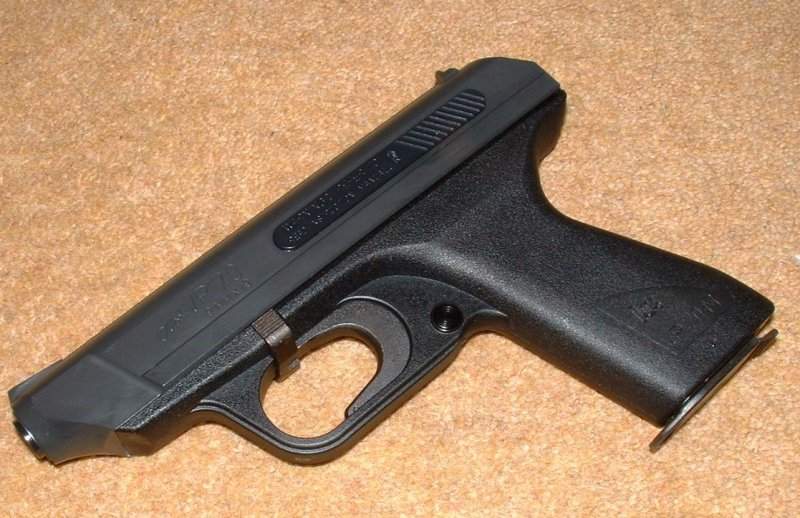
The VP70 created a lot of excitement in the airsoft world and I decided to buy one, to see if it could live up to his reputation.
In the Box
The box is very different to most airsoft boxes. I suppose, externally, it is most like Maruzen's with line drawings of the content and lots of broken English, bullet point descriptions of the contents, such as "BB Air Machin Pistol", "3bursted STOCK" and "For comretitive use".
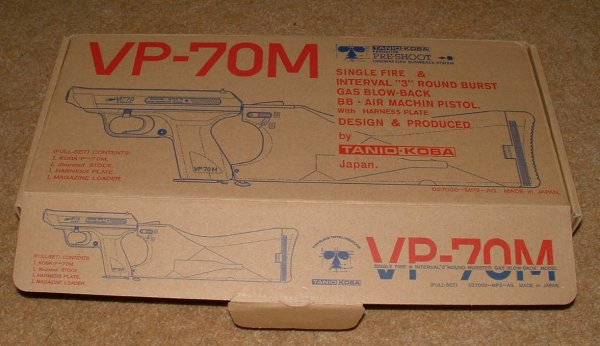
Inside, the box is very environmentaly friendly, with just corugated cardboard to protect the contents, no Polystyrene here!
The gun itself is not immediately visible. There is what looks like the back end of a FN P90, and a square plastic thing on the top, more on which later.
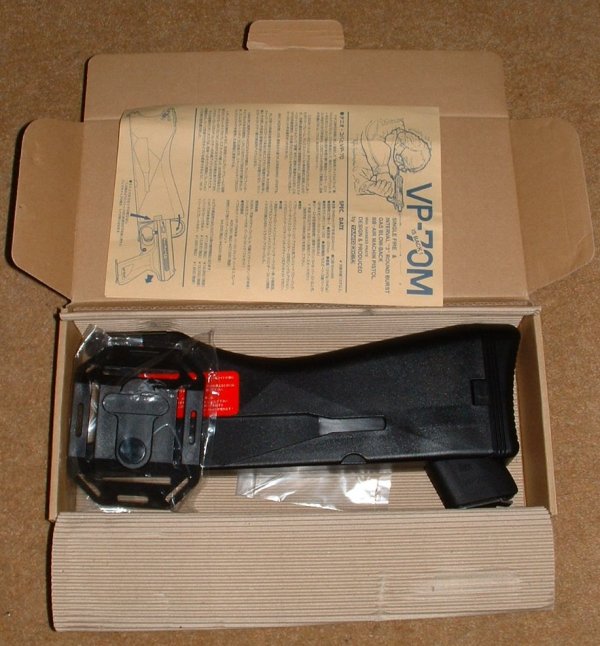
The gun is, wrapped in a plastic bag to protect it, inside the stock, which doubles as a holster, very much like the Mauser C96 holster/stock of old.
Other than that, there is just a piece of wire with a loop on the top, which is a speedloader of sorts and the manual/leaflet.
First Impressions
The stock looks good and as you withdraw the gun, it feels solid in the hand.
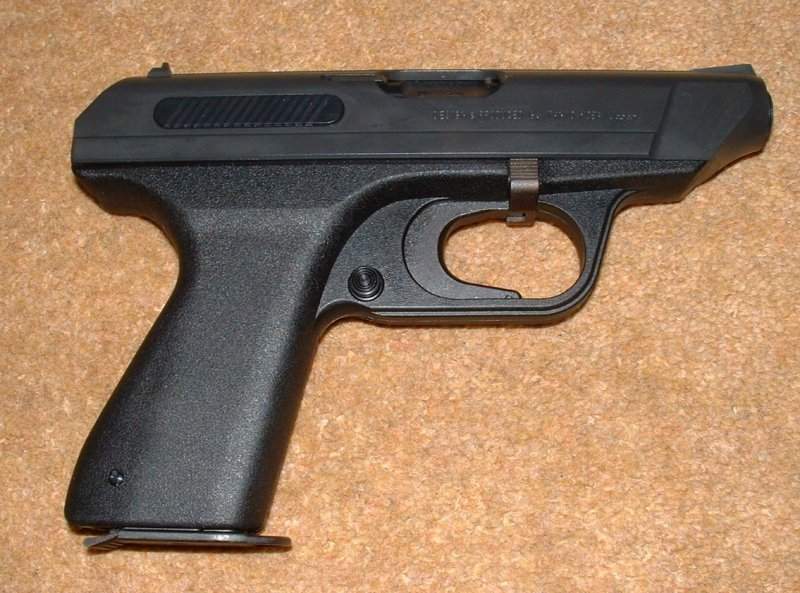
This initial feeling is slightly tempered by the very cheap looking slide. It's very plastic in appearance and prominent seam marks (which no self respecting springer would bear) are evident behind the rear sight and under the front of the gun. There are seams, too, on the frame, but being darker, and an altogether more solid looking material, they are less noticeable and, probably, more forgivable.
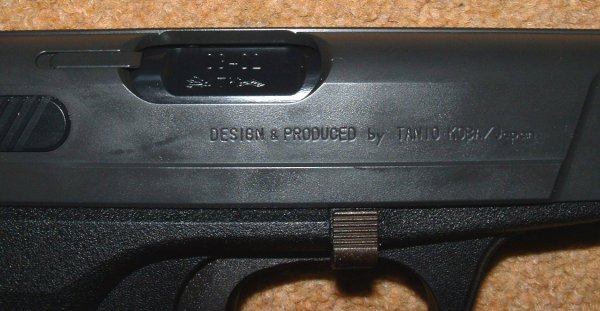
The slide also bears very non-Heckler & Koch markings. Whether the prominence of Tanio Koba markings are due to an enormous ego or a limited licensing budget, I cannot say, but purists won't be impressed in the least.

The grip, bears reasonable looking renditions of the HK logo and the VP70 markings, but, otherwise the frame is bear.
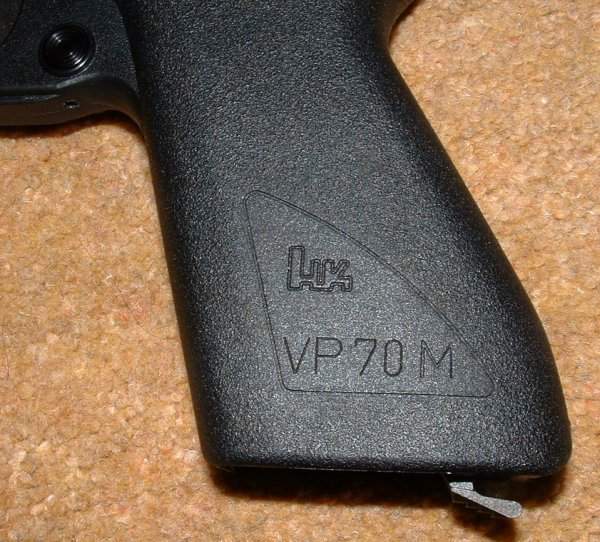
The stock is nice and solid and the selector switch is prominent (and well made) up on the top left. The stock slots solidly into the gun and together it feels a very solid, complete unit.
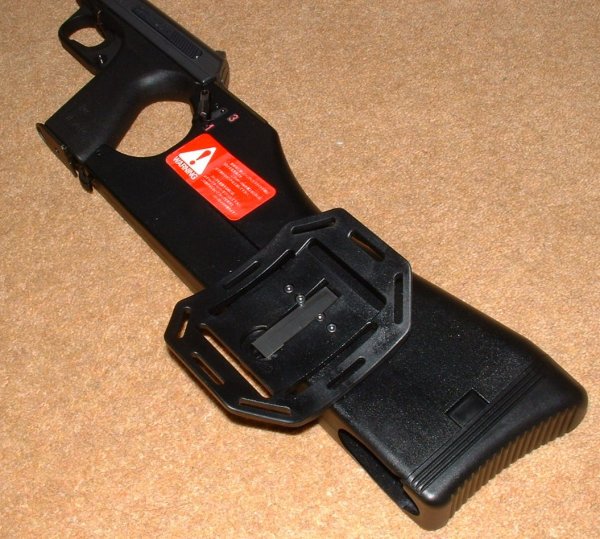
Closer Look
The VP70
Actually, there is not that much to see on the VP70. The real gun was the first Polymer framed pistol and features the internal hammer mechanism, so familiar on Glocks these days.
The frame is a smart, solid looking charcoal grey material, with little more than the HK logo and VP70M on the stock and the metal take down catches (within the trigger guard) and safety button (behind the trigger, but ahead of the grip - Push it left to right for safe, reverse to disengage) to disrupt the plain-ness.
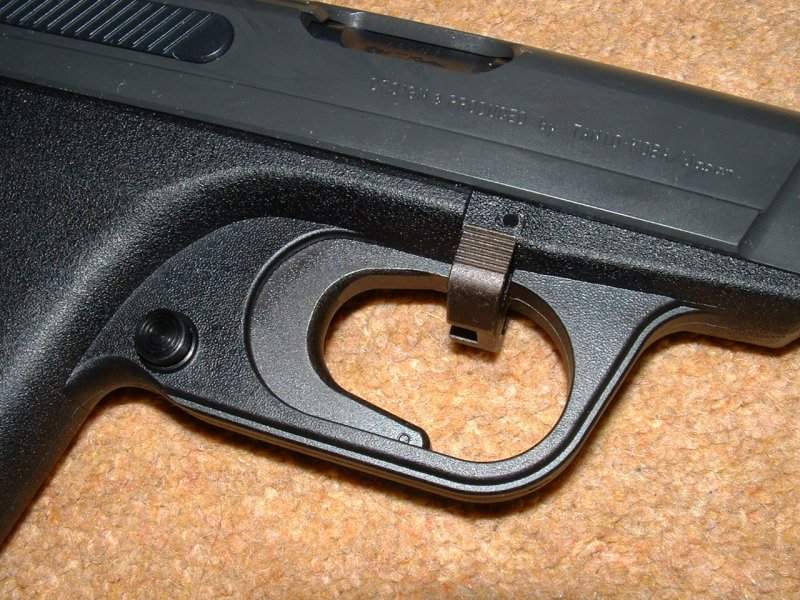
The real steel VP70 has a notoriously heavy (some say 20lb!) trigger pull, but thankfully Tanio Koba chose to skip this and the distinctive U shaped trigger is pleasantly weighted, although the pull is quite long, with a Double Action only action.
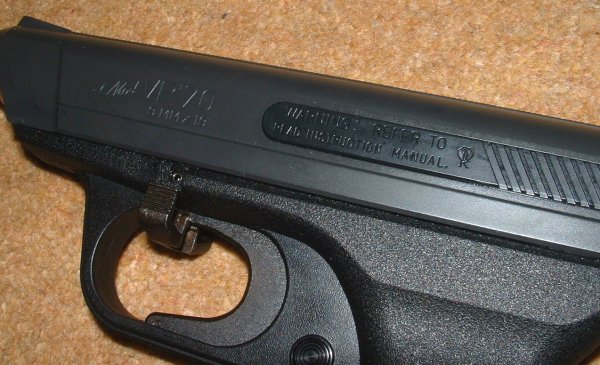
As I have already observed, Tanio Koba have gone to no lengths to faithfully replicate the original H&K markings, prefering to show its origins as an airsoft pistol. There is an obvious market for a replacement slide, without the seams and with proper H&K V70M markings. However, at $200, you cannot help thinking maybe you have already spent enough!

The slide is marked "Mod. VP'70" on the forward of the left side, with "9 MM X 19" below it. Further back, on a plate of the same design as the VP70, rather than the later VP70M, that this purports to replicate and the grip matches, is the bizarre script "WARNING : REFER TO" with "READ INSTRUCTION MANUAL" below. Behind these two lines, and still on the plate is the TK logo and some serrations to aid racking.
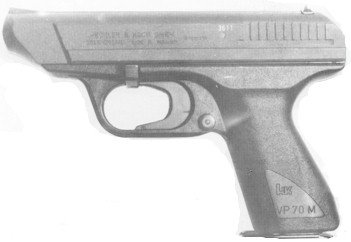
On the right side of the slide is the legend "DESIGN & PRODUCED by TANIO KOBA/Japan". The chamber cover bears the TK logo and a serial number of "03402", which appears to be identical on all guns.
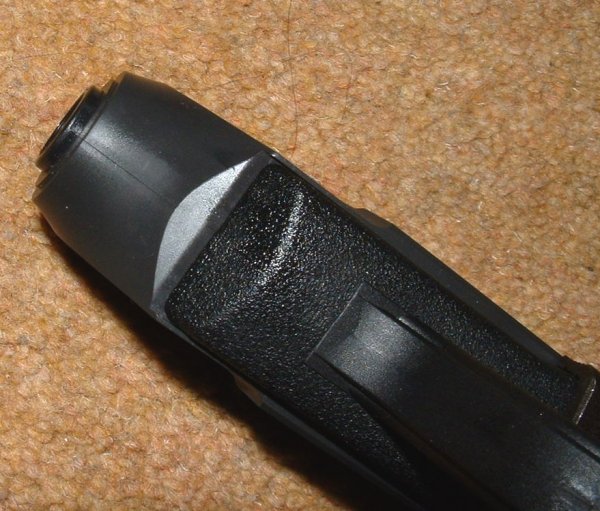
The Tanio Koba magazines look good. The are all metal, with an easily accessible gas valve and a flat black finish. I suspect they will scratch easily, but that will probably lend them some character, rather than making them look tatty. If all the gun looked this good, no-one would have reason to complain. The magazines hold 27 rounds, in a double stack and are a pour in design. Although no hopper is provided, there's a clever wire device with a thumb loop on one end which you use to depress the follower - It works remarkably well.
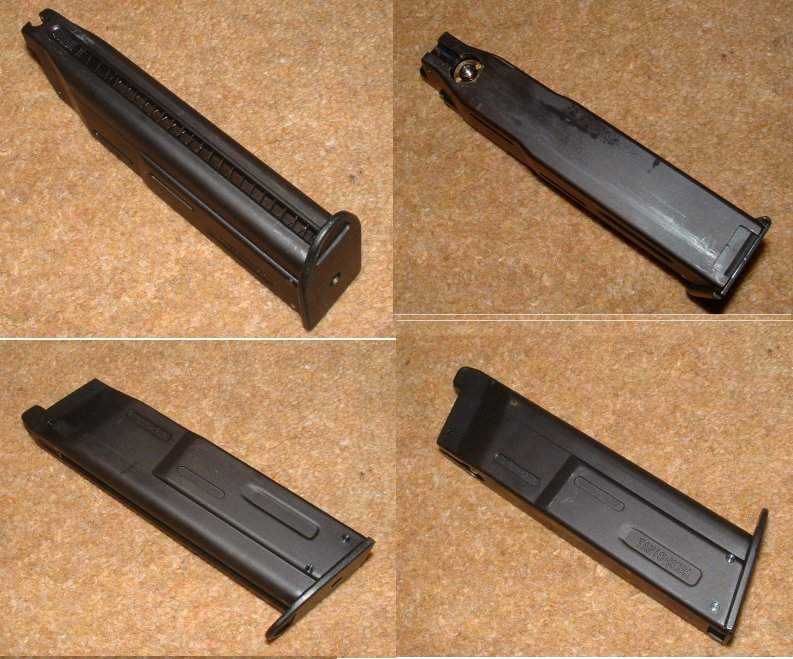
At the rear of the gun, there are two slots. The one at the bottom, behind the Walther P38 style magazine catch, takes the lower catch of the stock, whilst...
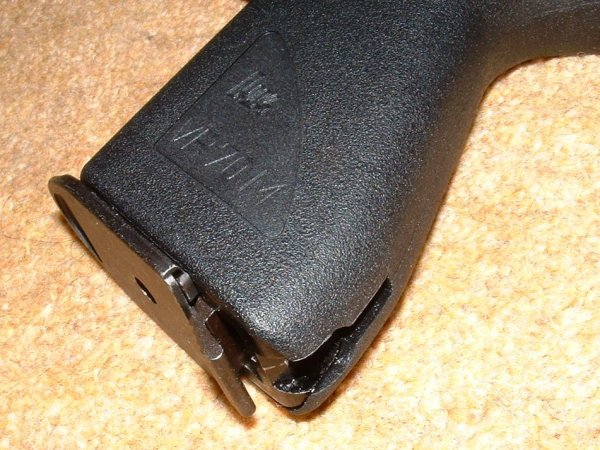
...the upper one takes the upper catch and selector rod.
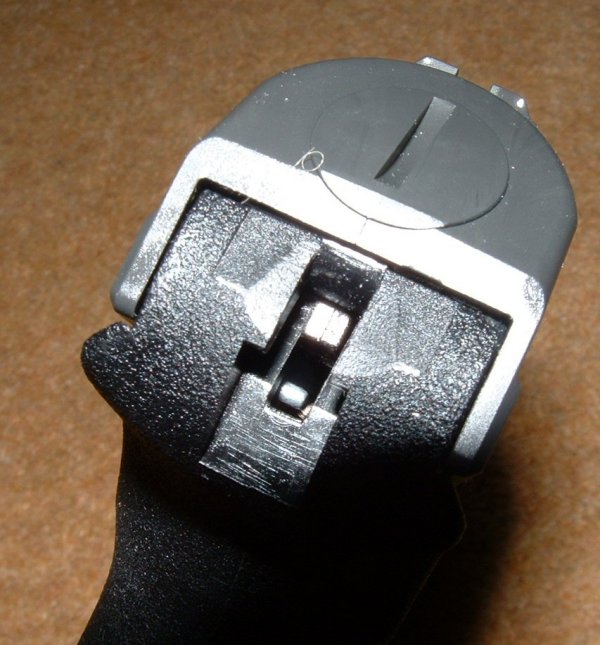
The sights on the VP70 are interesting. The rear is a simple groove, but the foresight, on the real thing, is made up of two highly polished metal ramps, which produce a shaded slot between them. This gives the effect of a post. I have no idea of the theory behind this, but TK have 'replicated' this by painting two white stripes, which I am sure are not as effective. However, in reasonable to good light, the effect works well enough and it is not difficult to sight the gun, although others have said it can be in poor light.
Tanio Koba are to be praised for producing an airsoft pistol almost exactly the same weight as the real thing, with and without the stock.
The Stock

When fitting the stock to the VP70, it is essential that the selector switch is set to 1, for semi auto. Apparently, not doing so can damage the internal mechanism on the VP70 itself.
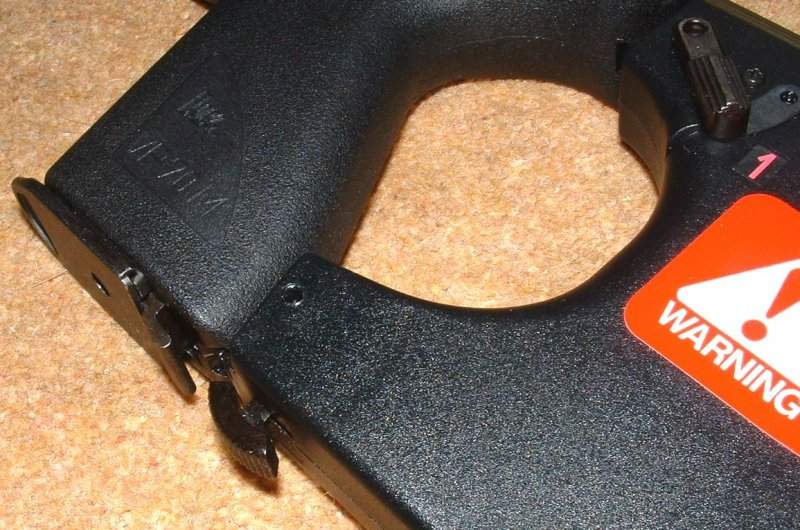
There is a lever/catch at the bottom which locks and unlocks the stock onto the gun. So far (after about 5 or 6 fitting and removals) there is no way the catch is needed, as the two are a very tight fit, but no doubt with further use, the catch will be useful to keep the connection tight.
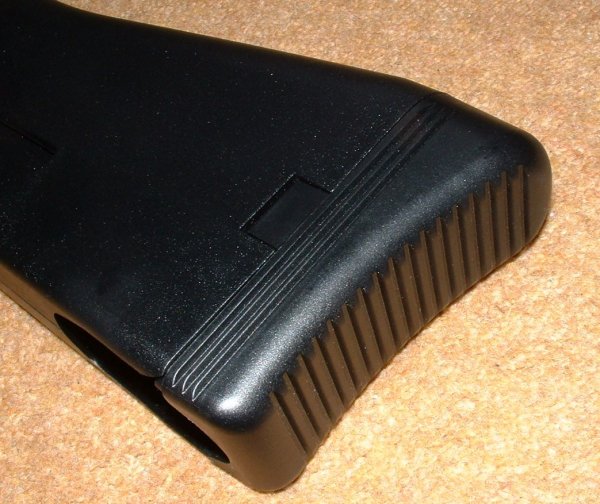
The butt at the rear is unpadded, but is comfortable against the shoulder and hinges (on flexible white nylon tabs, rather than traditional hinges - I don't know if this bears any similarity to the original) to allow the gun to be stored inside. There is a cutout under the stock, to permit the grip of the VP70 to pass through. There is also a tapering slot cut in each side of the stock, which permits the 'harness plate' to be connected to it. This is supposed to help you attach the stock to a belt and, also, help with concealment by standing the stock slightly off from the body and keeping it perpendicular. Clearly, you would need a pretty baggy jacket to conceal the VP70 and stock.
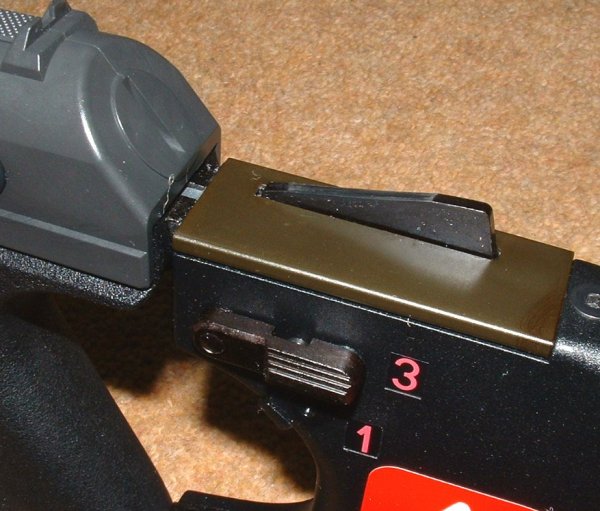
The selector switch, for semi auto (1) or 3 round burst (3) is found at the top of the stock. This is very difficult to impossible to engage if the stock is not correctly attached to the gun, but switches with impressive precision once they are aligned.
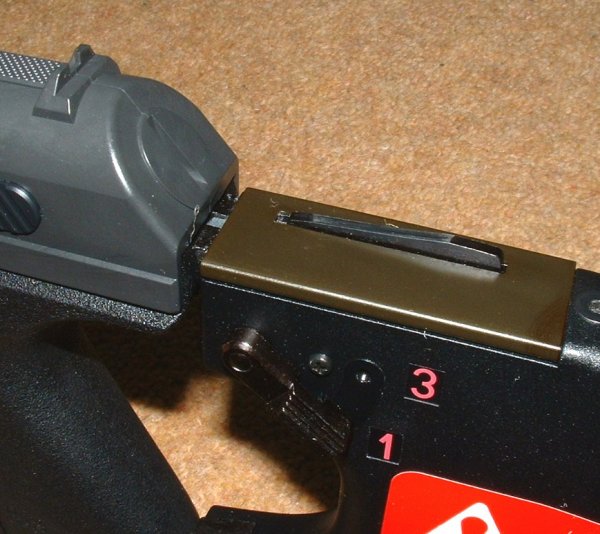
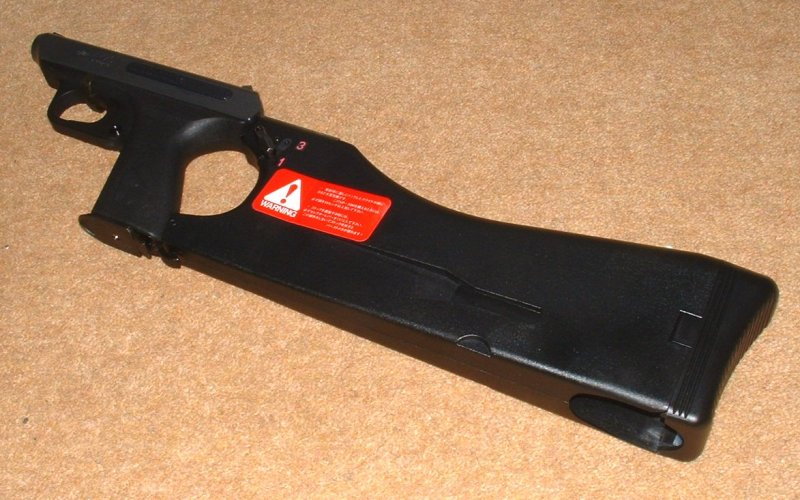
Shooting Impressions
Carrying out my standard 5m/6 round, off hand test was only partly applicable to this burst fire, stock equipped gun, so I carried out the testing in three phases.
First, I fired off 12 rounds in 4 bursts of 3, with the stock attached, as required to get burst fire.
These (shown as circles on the target) were especially impressive, with all but one of the rounds falling in a 2.25 inch (5.7 CM) diameter, much better thantypically seen with full auto/burst fire guns, like the Glock 18C, Beretta M93R or WA SVI Prokiller.
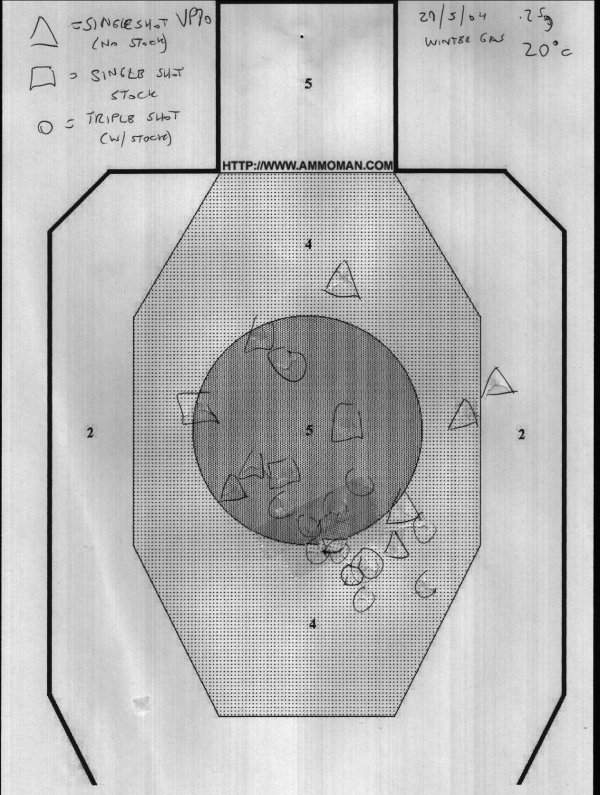
Click on image for bigger version in separate window.
Switching to single shot, but still with the stock attached, I placed 5 shots in the centre of the target (the square marked hits on the target), but my .25g BBs jammed in the magazine a number of times and the gas vented, so I gave up at that point. The grouping was 2 inches (5 CM) across. Reasonable for a GBB, but nothing astounding.
Finally, I fired off 6 rounds in hand held semi-automatic mode. This grouping (shown as triangles on the target) is 4 inches (10 CM) in diameter. This is, frankly, poor for a GBB and I will be returning to this with .2g BBs at some point as I suspect the gun is very sensitive to BB quality. Chrono testing with .2g Excel BBs produced no misfeeds or gas venting issues over a dozen shots.

Click on image for bigger version in separate window.
As I had had fewer problems with the Excel BBs in chrono testing, I went back to test the semi-auto again with them.
I fired off around 100 rounds all told, putting the stock on for a few, and then ran two sets of 6 shots. I did experience some jams during this testing and a number of vents, although these seemed to be related to low gas levels.
This time, the best grouping (marked as squares on the target above) was 3.25 inches (8.3 CMs) across. This fell as four rounds to the right of the aim point 1.5 inches (4 CM) across and two rounds at the top of the target centre, virtually overlapping. Slightly better, but given the amount of practice I had (I shot more rounds with this than any other gun in a single session), it still seems poor.
Over 10 shots, the VP70 averaged 283fps (using 134a gas) outdoors (around 20C).
| Shot | FPS |
| 1 | 260.0 |
| 2 | 279.7 |
| 3 | 281.6 | 4 | 264.0 |
| 5 | 289.6 |
| 6 | 285.0 |
| 7 | 286.1 |
| 8 | 297.7 |
| 9 | 294.3 |
| 10 | 292.3 |
The trigger pull weight test produced a figure of 1,360g (47.9 ounces), which is a medium-heavy weight trigger pull.
Take Down
Take down on the VP70 is impressively simple. With the magazine removed, push down the take down catches in the trigger guard. These will lock down.
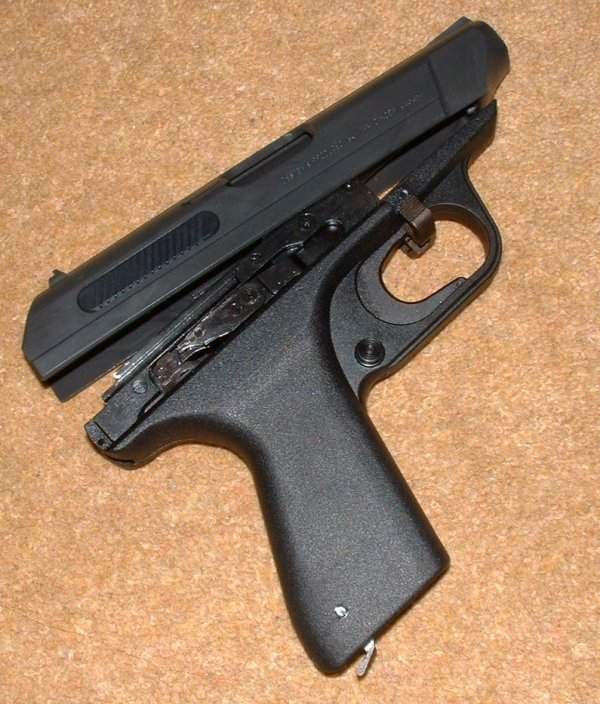
The slide can then be slid back and well lift off of the frame as it moves towards the rear.
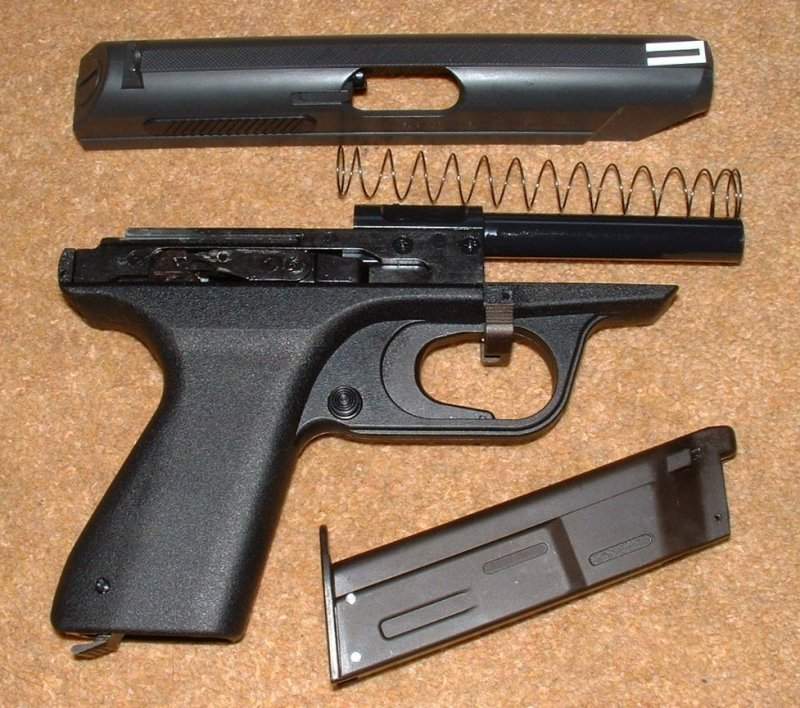
At this point, slide the slide forward and it will slide off the frame, revealing the fixed (as on the real steel) barrel and the recoil spring.
There is impressively little inside the VP70, which replicates the real thing well.
Internally, the VP70 looks well made, with what looks like stainless steel used in the blowback and hammer/trigger mechanisms.
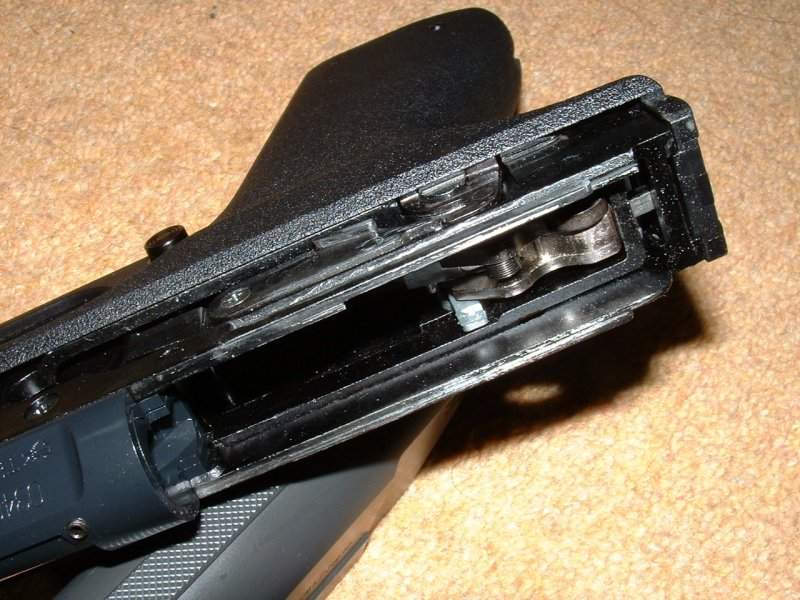
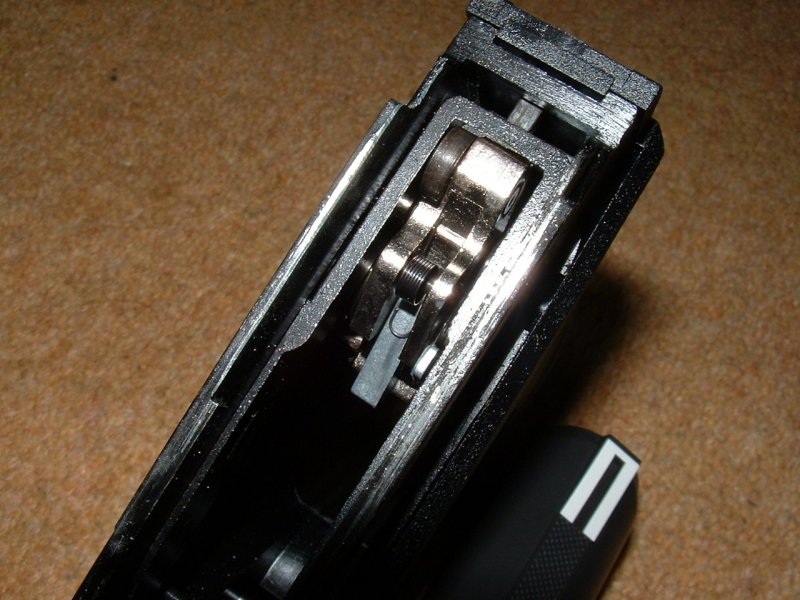
The nozzle itself is plastic, but the frame which supports it is metal, possibly stainless steel.
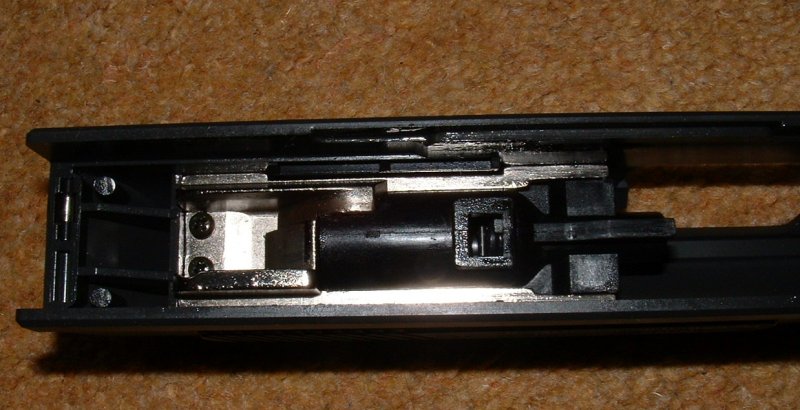
Only time will tell if the Tanio Koba VP70 is reliable, but it looks quite promising.
Update - May 2007: I've never seen reports of a broken VP70 and shinjinMC posted this photo of a fully stripped VP70 on Arnies.
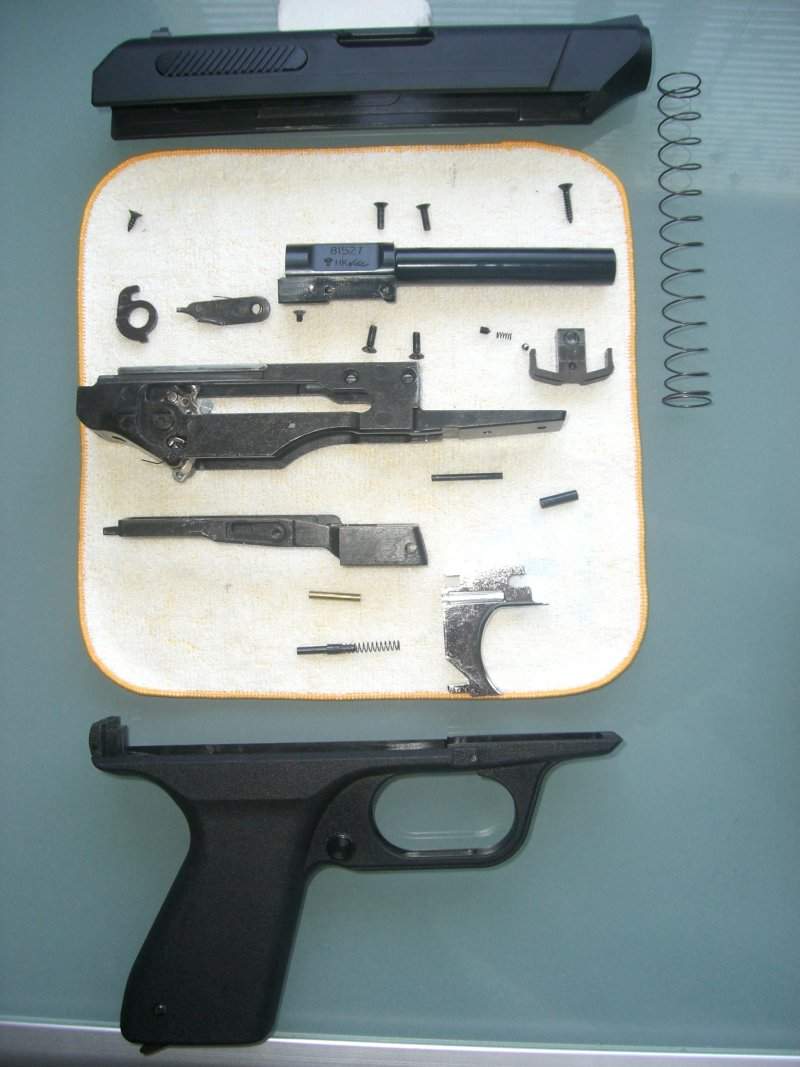
As can be seen, most of the internal parts are metal.
Conclusions
Overall, the VP70 is a disappointment. It certainly shoots well on burst fire, but the semi-auto accuracy is not great and it vents gas like a KSC Glock when low on gas (perhaps a trait of the internal hammer mechanisms).
The grip and stock look OK (probably no more, though, to be honest), but the finish of the slide is not acceptable on a gun at this price.
This is the most expensive airsoft gun I have ever bought and I do not feel it represents good value for money. Some will say it is not expensive for a gun AND stock and point to the quality of the internals, but the external finish is so far below that I have come to expect of KSC, Western Arms or even Tokyo Marui, that I would say it is poor value for money.
If the gun is made in small numbers, it will, no doubt prove to be a popular gun amongst collectors, but other than as a curiosity, there are much better guns to be had for the money.
Solider2004's comments on the VP70
Soldier2004, from the UKAN forum, also bought a VP70, from Airsoft Dynamics, and posted the following review.
Reproduced here with his permission.
I can't really disagree with anything that snowman has said about the way the gun looks. But that said, the reason I bought this gun in the first place, was that I was working in a weapons factory at the time a few of these come in for proofing, I just loved the look and style of this gun. It was a dream to use.
Something that snowman didn't touch on, was the size of this gun. If you've only ever seen one of these in a picture, you really can be forgiven for thinking that for a gun that looks "similar" in shape to that of (for want of better comparisons) a PPK, Tokarev, certain SIG's or a Mauser HSC, and thinking that this is of similar size..........well, it's not, this gun is large.
I recently bought a WA Infinity 5" Std, and the VP70 is just slightly larger than that. This is a large framed gun.
SM - Good point! This gun is 204MM long about the length of a standard length 1911.
I gave the gun a similar test to that of snowman's, firing indoors, using Abbey Ultra gas and 0.20g bb's and firing from a distance of 15ft (not exactly 5m, but near enough).
I personally thought the gun handled well, over 6 shots, the grouping was aroung the 3" mark firing without the stock and one handed, as was the next 6 shots firing double handed. Next, I put the stock on and fired another 6 shots, the grouping was slightly smaller, measuring at 2 1/2". Then I went on burst mode and found the grouping about the 2" mark. SM - Accuracy very close to that which I achieved.
Whether my gun was set better or not, I don't know, but I was pleased with the performance. If you're into pistols & CQB, then this is a great little item.
I found that the blow back on this gun is quite hard, especially on burst mode, not as hard as the TM Desert Eagle mind you, but a good comparison would be the blow back on my Infinity. I managed to get 1 1/2 loads out of a magazine before I needed to recharge it again.
My only gripes with this is
a) The price, you'd think that the £200+ that Tanio Koba commands for this gun, it would have a better slide.
b) The nylon strips that keep the butt plate attached to the stock. I don't care what antone says, but after much usage, these are gonna break/snap. Again, with a little thought, there is the room for improvement with a hinge system. No doubt someone will come up with one.
But all in all, this gun is a looker, I'm happy with it apart from my two gripes. So if anyones got £200+ to spare for a gbb and are looking for something different, then this is the gun for you.
Weight : 820g/1260g with stock
Realism : ***
Quality : ****
Power : ****
Accuracy : **/****(burst)
Jeff Chan's VP70 review - This was the first VP70 review on the web, but has since disappeared (unless you know better...).
Back to the Homepage